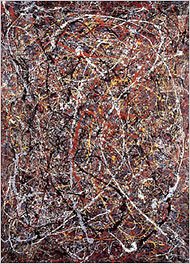Gopnik on Morris Louis
I agree with JT and also think that Blake Gopnik has written a superb piece in yesterday's WaPo of the Morris Louis retrospective at the High Museum of Art in Atlanta.
And also like JT, this review has sort of thrown me for a loop, because it appears to reverse some "set-in-concrete" Gopnikisms that often re-appear in most of his writing, as Gopnik defends Louis' reputation in the art world.
He writes:
By the 1980s and '90s, there came to be a sense that Louis's work was just fiddling around with pretty paint. It was billed as self-indulgent, disengaged from things that really matter in the world or in art. It was simple-minded and content-free -- all looks and no brains. The art world equivalent of the hunky jock or dumb blonde.I wish he would have quoted some evidence for these statements, which are the heart of his defense argument. I was in Israel for a while in the 1980s and seem to recall a big Louis exhibition there in the 80s. Also Louis' Catalogue Raisonné was published in the 80s.
It's also interesting in the sense that Gopnik is essentially saying that "they" were wrong in judging that "Louis's work was just fiddling around with pretty paint," when in fact Gopnik routinely writes pretty much the same thing about any contemporary painter today, as he preaches from his WaPo pulpit the "painting is dead" slogan.
Anyway - it's a minor point.
There are things that interest me on a local level about Louis (who studied art at MICA and then worked on WPA murals in Baltimore public schools), but another Gopnik point raised my interest as well.
Gopnik points out that "he [Louis] often started his paintings by pouring on pleasant veils of color, to make something like the spillings of a watercolorist. These echo the passages of pastel color in the "stain" paintings of Helen Frankenthaler, which Louis saw on a rare, career-changing visit to New York in 1953. (That was when his Washington colleague Kenneth Noland introduced him to the painter and her new techniques, as well as to Clement Greenberg, her lover and the most influential critic of that time. He became Louis's great champion.)"
Mmm... although it is clear in an art historical sense that Louis' visit to Frankenthaler was indeed very influential on Louis's future, I think it was more so in the meeting of Greenberg, who later became the inventor and father of the Washington Color School and indeed their great champion.
It's hard to imagine where Morris Louis' standing in the rarified upper crust of the art world would be today had it not been for Clement Greenberg. In Tom Wolfe's "The Painted Word," Wolfe describes (and makes fun of) the meeting of Greenberg and Louis and pokes fun at Greenberg:
Greenberg in particular radiated a sense of absolute authority... Likewise his prose style, he would veer from the most skull-crushing Gottingen scholar tautologies, "essenses" and "purities" and "opticalities" and "formal factors" and "logics of readjustment" and God knows what else.According to Wolfe, when Greenberg described painting as "flat" to Louis, a light-bulb went on in Louis' head, and the rest is art history (see page 49 of Wolfe's book).
Anyway, Gopnik elevates this visit to NYC as a "rare" event, which I find peculiar, since Louis had actually lived in New York for four years (1936-1940) while he was in his mid-20s, and while there attended the workshops of Mexican muralist David Alfaro Siqueiros.
I find it peculiar, because I had always understood that Louis' began to develop a sense of abstract style in his painting upon his return to Washington, DC in the 1950s, in somewhat of a personal response to the New York School of abstract painters, many of which he may have known personally and met while a young twenty-something living in NYC.
While it was indeed the exposure to the Frankenthaler "stain" paintings that kick-started the Louisian mature "response" (both Kenneth Noland and Morris Louis have cited their exposure to Frankenthaler's work as a catalyst to the formation of their own mature style), and it was indeed the enlisting of Clement Greenberg, the world's most powerful art critic (at the time), that sealed Louis' future as an modern art icon, I'm not sure if the visit to NYC was such a "rarity."
I know, I know... but I'm a Virgo.

